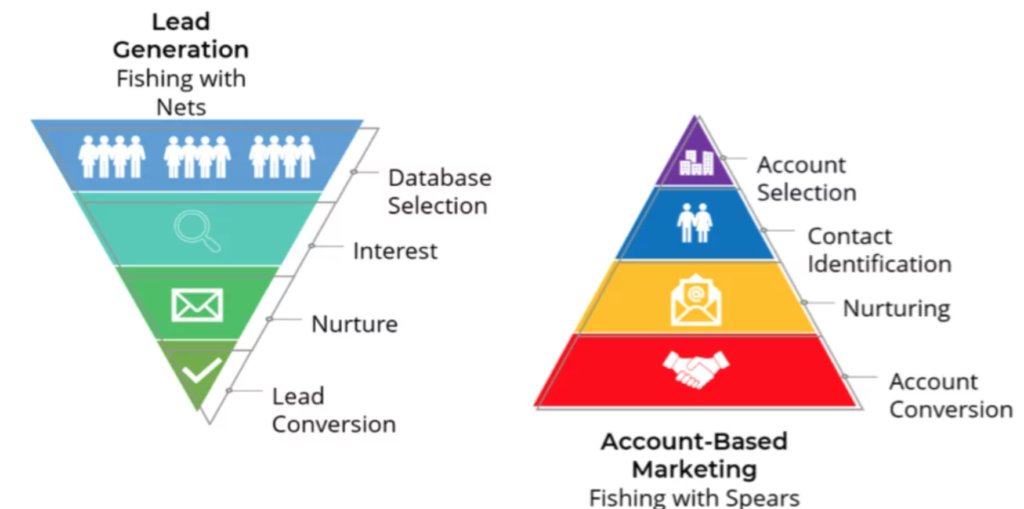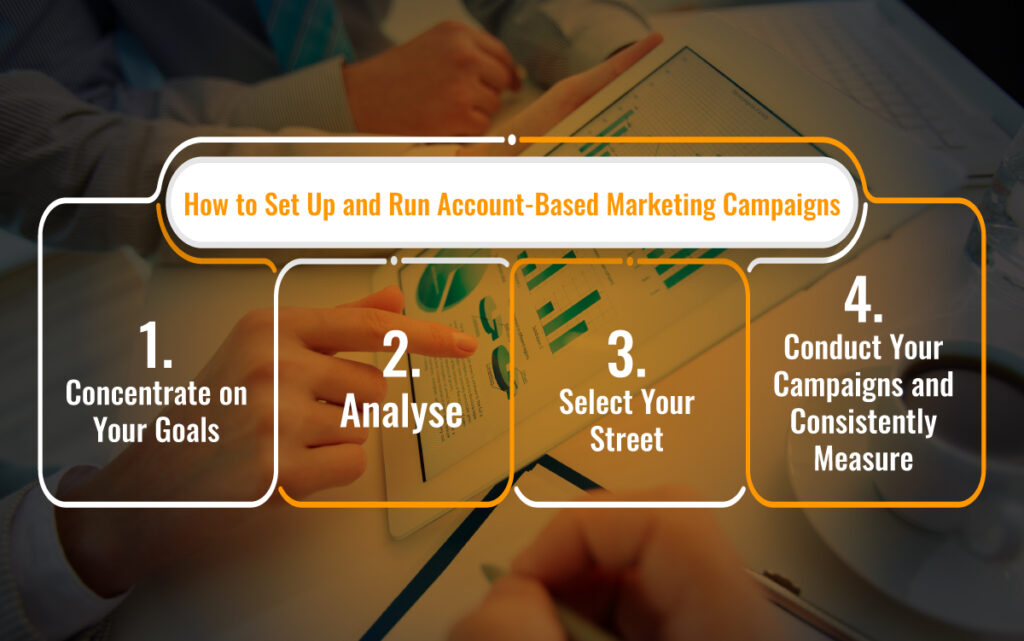
The average click-through rate for emails is 2.6%. Direct mail has 1% return on investment. A successful social media campaign will convert at a rate of less than 1%.
Why are these figures so small? Because many new marketing efforts lack the proper segmentation, personalization, ideal client representations, or customer research. To check if anyone bites, they hang a worm in the air.
Because of these crucial elements, account-based marketing presents a fantastic opportunity. It is a terrific technique to identify the perfect customer who will pay you on a recurring basis.
That is the kind of customer you desire, and that is what this article is focused on.
Must Read: Account Based Marketing Tactics in 2023
Account-Based Marketing: What Is It?
The sales and marketing teams collaborate in account-based marketing to identify the most eligible accounts for conversion into customers.
Here, you are inverting the conventional sales funnel.

I adore the comparison between spear fishing and using nets for fishing.
To meet the demands of your client persona, you toss out a generic marketing campaign when you “fish with nets,” but you never know what will catch.
With the aid of your sales staff, you may target the customers you desire while spear fishing. The marketing team will be able to develop a campaign that appeals directly to this group by working together to identify ideal customers.
Must Read: Measuring the ROI of Account Based Marketing Strategy
Account-Based Marketing Examples
The way account-based marketing operates is by developing campaigns for very particular target markets. You are able to tailor campaigns in a way that you have never been able to before by starting off with a certain target audience in mind.
Here are some actual cases where account-based marketing has been used.
Must Read: Account Based Marketing Framework
Webinars
Consider that you are trying to reach an outdoor store that makes specialized kayaks for commercial fishers. That’s a rather niche group of people, right? You could organise a webinar just for marketing custom kayak businesses.
Live Events
A live event that takes place in person is superior to a webinar. As you prepare this event, work with the sales team to identify the most important prospects. For the customers you want to close, you may also develop customized upsells like VIP tickets, VIP rooms, or souvenirs. Read this insightful article about different types of Account Based Marketing.
PPC
Account-based marketing can be used to reach high value customers using Google Ads, Facebook, LinkedIn, and Instagram. Once you’ve determined who you want to reach, you may develop targeted marketing for that select few customers.
Recall the comparison between spear fishing and net fishing? We’re not just casting a net out to see what we can capture any more. We are aware of where it is, what we want to catch, and how to obtain it. We simply have to act.
Must Read: Top 5 Secrets to Generating Great Revenue with Account Based Marketing
Account-Based Marketing: When and Why to Use It
In order to “play the game” and discover what’s available, we frequently start the funnel with a broad-based marketing strategy. We need to eventually go past that and zero in on the customers who will pay us what we’re worth and remain with us.
This is what I refer to as the “perfect client.” Account-based marketing assists you in contacting these clients once you are aware of who they are.
Here are some scenarios when account-based marketing is most appropriate:

Source: DemandBase
To integrate marketing and sales
Lack of communication between the sales and marketing teams is one of the main problems that many businesses encounter. These two departments now have the opportunity to collaborate, comprehend a shared objective, and support one another thanks to account-based marketing.
Must Read: Account Based Marketing Platforms
Boosting Engagement
If they are not engaged, that may be a sign that you are targeting the incorrect group. This can also be an indication that your marketing strategies are getting old.
How many times have you seen advertisements so frequently that you no longer pay attention to them?
When this occurs, it’s time to alter things up and adopt a tailored approach that will speak to a certain audience.
To increase ROI
To move as many individuals through the funnel as possible is the objective of both marketing and sales. That is a crucial sign of success over the long run.
Rather of inviting everyone, it is much better to bring competent individuals via the funnel.
Only the best qualified accounts enter the funnel if we place a strong emphasis on ROI. You will save time, money, and resources by doing this.
Must Read: The Most Effective Methods For Creating ABM Target Account Lists
Account-Based Marketing’s Strengths
Let’s now discuss the advantages of an account-based marketing plan over one that is more general.
More Rapid Sales Cycle
You may save a tonne of time and money by shortening the sales cycle. This is only one of the ways that an account-based marketing strategy optimizes ROI.
Instead of exhausting resources to interact with staff members who might not have that power, you can get in touch with important decision makers directly and early. You know you can serve and charge decision makers since you are directly addressing them.
Personalization Reduces Cost and Saves Time
How frequently does your sales team spend time talking to potential customers who barely comprehend what you do? That represents widespread marketing.
With account-based marketing, you draw customers who are already interested, knowledgeable, and prepared to buy. In the long term, tailored marketing like this saves time and money.
Must Read: 6 Key Performance Indicators to Track Account Based Marketing
Easy to Measure ROI
We concentrate on fewer prospects as the funnel becomes more narrow. As a result, it is simpler to calculate the ROI and provide superior outcomes.
For instance, we may determine our account-based marketing conversion rate is 10% if we reach 100 potential clients and convert 10 of them.
This is far better than doing a marketing effort around the entire east coast, converting 10, and then having four of them leave after the first month.
As an alternative, you are cultivating long-term, highly qualified leads (Marketing Qualified or Sales Qualified) that will remain loyal to you.
How to Set Up and Run Account-Based Marketing Campaigns
Let’s put account-based marketing into practise now that you have an idea of it by outlining some concrete measures you can take.

1. Concentrate on Your Goals
Who is the perfect customer for you?
To identify some warm prospects, collaborate with the sales staff. What traits would you use to characterize them? What kind of income do they receive? What systems do they use to work?
Utilize all of this data to create a customized marketing strategy.
2. Analyse
Make a lot of research. Determine what motivates prospects, then come up with inventive concepts that will make them feel as though the marketing campaign was tailored specifically for them, which it was.
3. Select Your Street
Where will you advertise to this market? What tools will you use to do it?
Do platforms like Instagram and Facebook have a younger audience? Do elder executives prefer live events or direct mail?
Before launching your campaign, you should consider these important issues, especially if you want to reach your target audience and increase your ROI.
4. Conduct Your Campaigns and Consistently Measure
Building up enough data before drawing any conclusions is something that marketers are recommended to do when executing PPC, social media advertisements, or any other form of campaign. Account-based marketing presents a few unique challenges.
When you have a small audience, your whole advertising spend might go really rapidly. You should keep an eye on these campaigns often to assess if your strategy is working. If success doesn’t show up right away, you should make the necessary adjustments.
Recommendations for Using Account-Based Marketing
Here are some more advanced suggestions for optimising your account-based marketing initiatives.
1. Plan every detail
The marketing initiatives must be extremely focused because you are going after a certain account. Important information includes that on rival businesses, client relationships, selling and purchasing points, and top-selling goods and services.
2. Cooperate with the sales team
Make sure everyone is on board, from the marketing department’s president to the new sales trainee. Since both parties want to attract these high-ticket customers, there should be no misunderstandings.
3. Establish a Committed Account-Based Team
Before they become customers, you should have a group of committed account managers working with these prospects. In order to simplify interactions and reduce the number of individuals you need to communicate with before a closure can occur, their focus should be on establishing connections and comprehending the demands of each account.
4. Set a Limited Goal
Don’t disperse yourself too widely. By focusing just on two or three high-value accounts, you can be confident that your efforts are speaking directly to their requirements and highlighting relevant aspects.
Going too far too soon increases the likelihood that your campaign may alienate some or all of your target accounts.
5. Intervene Only With Decision Makers
You need to make sure you aren’t wasting time because you are investing a lot of resources in these two or three accounts. Dealing solely with corporate decision-makers is crucial. They are not a high-value target if you can’t pinpoint individual decision-makers.
6. Focus Only on Warm Prospects
Along with contacting decision-makers, collaborate with your sales staff to identify the most welcoming targets. They are aware of who you are and have previously expressed interest, but they never become followers.
7. Don’t be averse to change
Measure your outcomes, make necessary adjustments, and collaborate with all parties to see what you can do differently.
Endgame: Account-Based Marketing
For businesses of all sizes, account-based marketing is a wise decision since it enables you to develop closer ties with customers who will be more significant to your bottom line.
Adopting this method will attract the precise kind of customers you want to maintain high retention rates and create a solid base. Create your ideal buyer persona with the help of your sales team, then choose a channel to target that demographic.
Which strategies are you going to try out first? Tell us in the comment section. And if you are looking for some one to assist you, you know where to go.
Must Read: A Brief Guide to Generate Leads Using ABM Content Syndication

Vikas Bhatt is the Co-Founder of ONLY B2B, a premium B2B lead generation company that specializes in helping businesses achieve their growth objectives through targeted marketing & sales campaigns. With 10+ years of experience in the industry, Vikas has a deep understanding of the challenges faced by businesses today and has developed a unique approach to lead generation that has helped clients across a range of industries around the globe. As a thought leader in the B2B marketing community, ONLY B2B specializes in demand generation, content syndication, database services and more.

